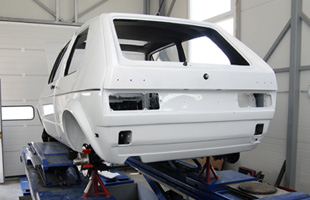
There are 4 levels of classic car restoration, each one should be applied individually depending on the kind of project, budget and purpose. These are the top 10 tips for those classic car aficionados who want to reverse the effects of ‘the sands of time’ on their vehicles:
- Sit down, grab a piece of paper, a parts catalog which would be relevant to the model you want to restore and run some numbers within your budget. Never deviate from it, otherwise the results will be obvious.
- Inspect your car very carefully, top to bottom, inside and out; use strong flashlights to inspect the trunk, the engine area, etc. This will help you see the kind of repairs needed to be done to this vehicle. If possible take it to a car shop where it could be lifted to take a good look at the condition from beneath. Here you will determine if a the restoration process is worth the time and money.
- After inspecting the vehicle, it is also important to decide whether you have a ‘solid’ car which can be restored without replacing the entire frame, floor, axles, etc. It would amaze you how this step can save you major dollars (Euros, Yens, etc.). By ‘solid car’ we are inferring that the car structure should be strong, as well as the floor; a little rust can be repaired but a completely rusty car which has the entire frame compromised will eventually crumble.
- Decide whether you want to work with a “friend who knows how to repair cars” or a professional. It is often recommended not to involve friends and family on such projects as the time and money invested on this process may cause some trouble if the right procedures are not followed. Cars restored by people other than professionals tend to run well for a couple of years and in some cases start to breakdown thereafter.
- Have a car restoration professional run some numbers and make sure they match or are close to the numbers you ran on step 1.
- Decide the level of car restoration:
- Driver restoration: is often performed to get a car back to a fully functional and operational condition, they often include part replacement and minor cosmetic adjustments.
- Street Show: this restoration level involves getting a car into a fully working condition and repairing all major cosmetic problems (body work is required). If judged by a professional it should fall within the 80-89 point range.
- Show Car: restoring a classic car back to this form often requires professional work, if judged by a professional, there restorations and labor quality will fall within the 90-95 point range.
- Concours: this is the highest level of car restoration possible. All the work should be done by professionals, from part replacement to body work. These type of cars are intended for auto shows or private collections and not to be driven. Obviously, the original car to be repaired must be in quite optimal condition to achieve this stage, otherwise a major investment is necessary.
